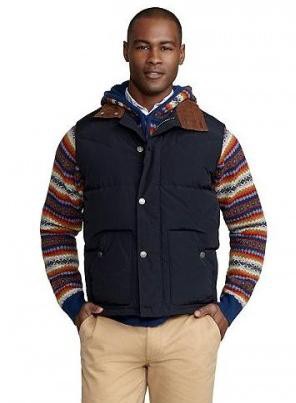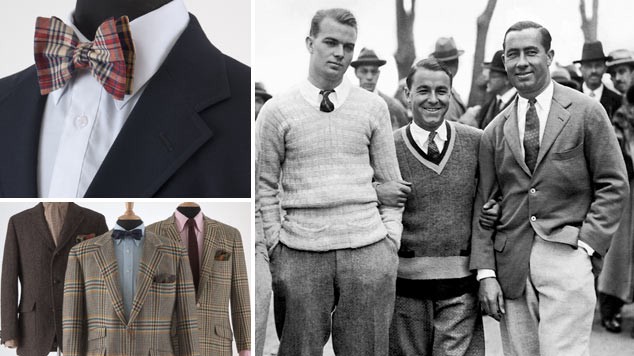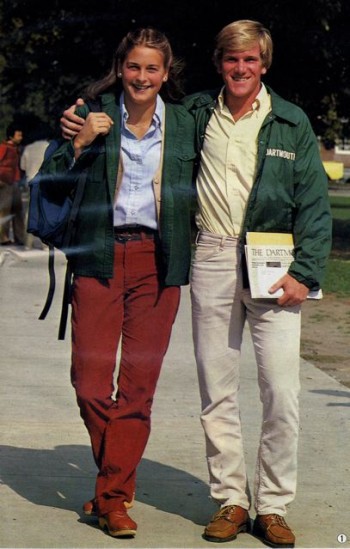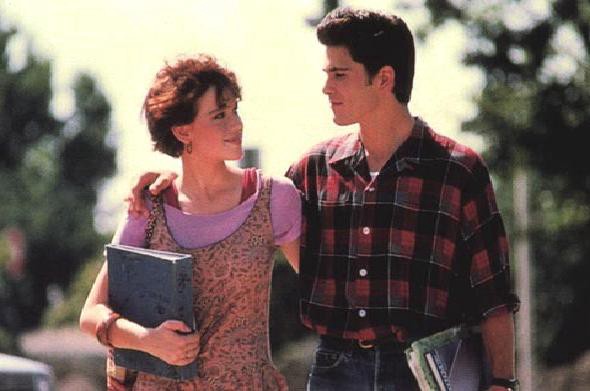The Burdens Of Pulchritude
“Is it better to be plain than beautiful?” I’m afraid you guys are on your own with this one, since, not knowing, I cannot say.
Consider The Urban Woodsman
Consider The Urban Woodsman
by Jason Diamond

George looked exactly how I expected someone who went to Yale in the 50s to look. He wore a tie every day. Round tortoiseshell glasses perched on his aquiline nose. His voice fell somewhere on the spectrum between Franklin Roosevelt and George Plimpton. George, like many of the men in his family before him, was a Yalie; a fact he brought up on an almost hourly basis. He also often mentioned his partner, Douglas, who had passed away a decade before. One specific story revolved around George’s embarrassment when Douglas, a Dartmouth student, visited him at school for the first time. Assuming George was alluding to the difficulties of introducing a boyfriend to friends in Eisenhower-era New Haven, I made some remark about how hard that must have been for him.
“It was,” George responded. “He wore boots just like yours all the time.” He pointed at my L.L. Bean duck boots. “You wear those things if you’re going hiking in the woods. You don’t wear them to walk Bucky in the city,” he said, referring to the Pomeranian he paid me seven dollars an hour to walk.
I was reminded of this conversation a month as I was looking at a post on Brooks Brothers’ Rogues & Gentlemen blog. Titled “Fall Essentials — Urban Woodsmen,” the post featured, alongside “indispensable” prep pieces like the tweed sport coat and the “updated knitted tie, items like a vintage-looking canvas rucksack, a navy puffer vest, and Red Wing boots (which Brooks Brothers now carries). These pieces of clothing, the copy explained, are ideal for “strolling down the streets of Manhattan or chopping down trees.”
The meeting of Ivy Style and rustic Americana is emblematic of the coasts moving inward to aesthetically meet in the Middle West; this is a considerable sea change for brands like Brooks Brothers. If those that historically cater to the 1% are offering styles borrowed from the 99%, what does that say about the brands’ evolution? George died four years ago, but as I read that post I pictured him turning over in his grave (along with an entire generation of former Ivy Leaguers) at the very thought that one of the pillars of the traditional Ivy League look was promoting navy puffer vests and work boots, both items of clothing that wouldn’t have cut the mustard for George. The generation he belonged to defined the traditional Ivy League look: custom-made suits, button-up shirts with button-down collars, ties and cuffed pants without pleats. And while we’ve all come to expect the woodsman look in Brooklyn (or on “Portlandia”), it’s finally drifting uptown, in a metaphoric sense. It took a while, but the plaid shirts and thick woolen wears of the New England weekend meanderer and the Minneapolis logger have coalesced with the traditional urban prep look, to the point that it’s getting hard to tell the two styles apart anymore.
This represents a pretty big shift for a company that in 1991 had George Plimpton write the copy for a six-page advertisement in The Atlantic. Plimpton extolled the company’s “brand of elitism,” and seemed shocked that Brooks Brothers had deigned to start selling blue jeans.
Brooks Brothers’ most recent embrace of the urban lumberjack look — a willingness to get their hands dirty, also — highlights an enthusiasm among sartorially-minded gentlemen to embrace a more relaxed idea of what formal dress can be (the flannel shirt is fine for the office if you pair it with a knit tie and tweed sport coat), and it also shows the latest evolution of the American preppy look. Once strictly an aesthetic native to old-money New Englanders and their kids en route to prep school and East Coast colleges, now Barbour hunting jackets are as acceptable part of daily wear in fall as pastel tennis shirts are the summer. Even Gant, another brand launched out of New Haven in the late 1940s, has seen their fortunes turn around thanks to a popular partnership with designer Michael Bastian, a guy who describes his influence as “deep-woods preppy.” It’s a look influenced by his growing up on Lake Ontario, not time spent at Yale.
***
Paging through the book Ivy Style, a history of Ivy League dressing forthcoming from Yale Press, you get the feeling that the traditional preppy look hasn’t really changed all that much from the look’s Golden Age in the late 1950s to mid 60s. If you look at pictures of students from Yale, Harvard and Princeton from the interwar years to the early 1960s (think Fitzgerald’s This Side of Paradise to Animal House’s wayback style, for pop-culture points of reference) you see jackets and ties, everyday guys dressed up in a way that might mark them as a dandy today. But as America relaxed culturally in the 1960s, you began to see the ties and jackets disappear, save for the sort of students who voted for Nixon and worshipped William F. Buckley. By 1968, Yale had abolished its jacket and tie dress code that had been instituted in 1952 to combat “Disorderliness” and “Sloppiness.” But even before the revolutionary days of the late ’60s hit Yale, the other Ivies started to mark a decline in the suit and tie look. As Richard Press, grandson of J. Press founder Jacobi Press — the other major supplier of wears for the traditional Ivy look — told me of his days at Dartmouth in the last years of the 50s, unless you were going to a formal event, “If you dressed up with a jacket and tie you looked like a shmuck in most circumstances.”

Traditional Ivy elements. (Images from Ivy Style, via.)

A pair of Dartmouth students in 1981. (Via.)
The 1970s weren’t the Ivy look’s best decades: long hair, beards, bellbottoms and t-shirts became commonplace. Young Republicans shopped at Brooks Brothers, Gant, Fenn-Feinstein and J. Press for their suits, penny loafers and button-down collar shirts. It wasn’t until the early 80s that America at large once more warmed to the preppy look. The satirical book, The Official Preppy Handbook, was a bestseller, and the Reagan-worshipping Alex P. Keaton of the television show “Family Ties” looked snazzy in his sport coats and suspenders. Along the way, even Andy Warhol traded in his leather jacket for a coat and tie from Brooks Brothers. As the country embraced conservatism, men’s style followed suit (both literally and metaphorically). After a period of slumber, the Ivy style had come roaring back — and not much had changed. Reagan promised to deliver us safely to the prosperity of the post-war years, Jerry Rubin went from yippie to yuppie, and “earthy” and “laidback” gave way to wide ties, pinstripes and shined shoes.
But while pinstripes and Ralph Lauren Polo shirts were all the rage among adults, the younger American preppy was comfortable mixing up the dressed-down look of their parents’ generation, but in a clean-cut way: Ski gear was worn off the slopes, and Maine Hunting Shoes were worn on the sidewalks of big cities. In 1984, Eddie Bauer teamed with Ford to create the very popular Bronco 2 SUV. And that same year, the first suburban lumberjack heartthrob came in the form of Jake Ryan, the wealthy, plaid-shirt-wearing object of affection for Molly Ringwald’s character in Sixteen Candles. Played by then-23-year-old Michael Schoeffling, Jake Ryan is essentially the patron saint of the urban lumberjack. Ryan’s ensembles included Oxford shirts under sweater vests with jeans, a pair of work boots and a clean preppy haircut. Whether he knew it or not, John Hughes was doing something more than making some of the greatest teen movies ever; he was telling the world it was perfectly fine to mix preppy with workwear. Jake Ryan may not have been the first urban lumberjack on film, but he remains the greatest, as well as a counterweight to the preppy rich kids of Hughes’ Pretty in Pink, Andrew McCarthy and James Spader.

Jake Ryan and one of his plaid shirts.
The 1990s gave new meaning to the phenomenon. Pacific Northwest bands like Tad and Mudhoney wore flannel shirts and jeans. Nirvana sold millions of albums and suddenly the grunge look was seen everywhere from your local Kmart to the Perry Ellis New York Fashion Week runway, where Marc Jacobs introduced his grunge-inspired collection for spring/summer 1993 to the world. But while grunge came and went in the span of a few years, the even bigger change to American menswear during the Clinton era was the growing ascendancy of Abercrombie & Fitch in malls across America. A&F;, long a sporting and hunting-supply company, underwent a total rebrand in the early 90s. No longer was it the store where Ernest Hemingway shopped to buy bullets for his rifle; now they were in the business of selling high-end and high-priced merchandise in a frattish style (or “neo-preppy” as Women’s Wear Daily dubbed it ). While some may scoff at the suggestion, A&F; going from hunters to frat boys was an important step in the progression of the urban woodsman.
***
These days, commenting on the hairy-faced gentlemen walking down the street in a major city has become passé. Yes, lots of guys have beards. Yes, you can see them all wearing black-and-red-checkered shirts as they lope along, carrying bags filled with artisanal this and that. They may look like they’re coming home from a weekend hunting trip, but they’re more likely on their way to their MFA program or band practice, dressed up in whatever Made in the USA gear A Continuous Lean is hyping that week. The look isn’t new, but now the menswear old-boy establishment is finally getting around to embracing the scruff.
So how did these two looks become intertwined? Maybe it’s a tonic for the allegedly growing American masculinity crisis. Putting on a pair of work boots to go sit in the office imparts a sense of gruff virility to the day that a normal pair of bucks don’t. Wearing a Carhartt jacket over your shirt and tie is tougher and closer to the popular conception of what is macho; therefore, so is the guy wearing the getup.
Nor can the Internet’s involvement be understated. Now we can easily see what everybody else is wearing. The barriers to entry when it came to style have been demolished by the egalitarian nature of the web — even if you’re not at an Ivy, you can see the look online. The same goes for guys generally stuck shopping from the ivory tower. There are a thousand Tumblrs and wannabe Bill Cunninghams and Scott Schumans out there to showcase each style and how they interact and influence each other across different continents and cultures.
All of those things lend themselves to the trend, but the real explanation is simple evolution.
Related: A Tale Of Two Tennis Shirts
Jason Diamond lives in New York. He also lives on Twitter.
Antbird!
“The ants are savage, relentless, capturing as many as 30,000 prey items in a single day. They scale trees to pull down giant scorpions, raid wasps’ nests and overwhelm the defenses of even the most violent Africanized bees. Any life form lying in the ants’ path knows its only chance is to try to leap away — and the antbirds know it, too. The birds swoop down and pick off as many of the harrowed menu items as they can get away with, a kleptoparasitism that ends up reducing the ants’ hunting success by one-sixth. Each of the three types of antbird makes its grab from a particular position around the swarm.”
— Though its title, “Feathered Freeloaders at the Ant Parade,” is a little Romneyesque for my taste, Natalie Angier’s article in today’s Science Times is almost certainly the most exciting story you will read about bird watching all day.
Best Time-Lapse Videos Not On The Awl (Until Now)
by Megan L. Wood
This post is brought to you by Intel, who is calling all inspired creators — submit a photo or a time-lapse and/or slow-motion video for chances to win amazing prizes. Click here to enter and win!
We recently saw five of the best time-lapse videos to have already appeared on The Awl. Now we’re back with seven more incredible time-lapse videos that were drifting aimlessly around cyberspace looking for one tidy home.
Corn, Roots, and Leaves Growing
Watch tiny seeds sprout into over five inches of solid corn growth in only ten days. Between the subsidies and the miracle of photosynthesis, no wonder corn syrup is so ubiquitous. I wonder if there have been studies that correlate banjo music with successful germination?
CollegeHumor’s Favorite Funny Videos
For all those times you think, I’m just going to get in a convertible and drive to the east coast. Pack scarves and be prepared to break down about three minutes and 10 seconds in.
If you plan on eating an apple today, I’d suggest not watching this video first. Or, play the video and eat your apple in 42 seconds before the white mold starts to make an appearance on screen. One of the more unappetizing time-lapse videos out there.
View more videos at: http://nbcnewyork.com.
Seven years of construction on the 9/11 memorial are condensed into one minute and 27 seconds.
Yosemite Range of Light from Shawn Reeder on Vimeo.
Filmmaker Shawn Reeder spent two years shooting scenes in the Sierras and Yosemite to make Yosemite Range of Light. Watch this video whenever you think New York City is the greatest place on earth and stop being such a placist (place racist). Nature rules.
Lotte Time-lapse: Birth to 12 years
Lotte Time Lapse: Birth to 12 years in 2 min. 45. from Frans Hofmeester on Vimeo.
If you’ve already seen this video on a Sprint commercial, you might think its uncool to sell out to a cell phone company. But Frans Hofmeester filmed his daughter every single week from her birth until she turned 12 — Frans earned his paycheck. I can’t wait for another 12 years to pass so I can see Lotte in her mid-twenties. Take note and step up your game, dads of the world.
You could rent an RV, score some hard drugs, not shower for a week, have unprotected sex in the desert, and admit to co-workers that you go to Burning Man. Or, you could watch this five minute video and get the gist of the festival without the urinary tract infection. So many pretty glowing lights.
People Punished For Doing Very Bad Thing
There’s got to be a special circle in hell reserved for those who would make a videotape and then, prosecutors said, use it to try to extort money from Stevie Wonder. At the very least, it would seem that Alpha Lorenzo Walker and Tamara Diaz have some bad luck coming their way, along with the 292 days time served and three years probation that they got in exchange for a no contest plea on an extortion count in Los Angeles. Speaking of Stevie, Talking Book, which includes the song “Superstition” and which I think I would choose as Wonder’s best album, came out 40 years ago next month. (I don’t know, maybe Songs In the Key of Life is his best. I mean, it doesn’t get any better than “As.”)
Burn It Down: The New Terrible Million-Dollar Brooklyn Apartment

Thar she blows! How much would you pay for an apartment in Carroll Gardens that is basically two unattractive low-ceilinged rooms on a “ground floor” plus a walk-in closet (or cozy “home office”), with a (truly) big backyard and 16 by 11 feet of storage in the basement? If you said $1,095,000, then you are 1. correct and 2. INSANE.
If you put 30% down (and WHY WOULD YOU, THAT IS MORE THAN $300K), then your mortgage and maintenance and taxes are a grand total of $5000 a month, because, oh yes, the taxes are $700 a month.
This is it. This is Peak Apartment. It’s all over. Everyone bought everything in Brooklyn because the interest rates were phenomenally low and there is nothing left except million-dollar apartments that you might not pay a million dollars for in Manhattan. This town needs a real estate crash. Everyone to Staten Island.
Raekwon, "The Scroll" (In Which Raekwon Compares Himself To Nicole Kidman)
Raekwon, “The Scroll” (In Which Raekwon Compares Himself To Nicole Kidman)
I like this new Raekwon song, especially the bongos and the Spaghetti Western whistle accenting the beat. It’s video, too — a Mission: Impossible-style espionage caper that takes place the city of Tilburg in the Netherlands. But it took me a while to figure out a reference to Nicole Kidman in the lyrics. Raekwon raps, “I’m like Nicole Kidman in the wind…” Now, Raekwon has always rapped in a heavy, cryptic slang; a lexicon sometimes known as “Wu-bonics.” It’s not always easy to parse his meaning. This time, I found it particularly difficult. Raekwon seems very unlike Nicole Kidman. In the wind or out of it, the resemblance is far from obvious. What was he talking about?
Was this a reference to Kidman’s acclaimed performance in the new movie, The Paperboy, in which she famously urinates on Zac Efron? Was Raekwon saying he was “pissing in the wind?” It didn’t seem like that: His voice sounds boastful, not frustrated.
Might Raekwon have been talking about wearing diamond jewelry? He often rhymes about this, and he often calls diamonds “ice” (as on his 1995 classic “Glaciers of Ice”) and Nicole Kidman has reportedly earned herself nicknames like “ice queen” or “ice princess” in some circles, due to a haughty and cold professional demeanor. This explanation seemed unlikely because it was hard to imagine Raekwon ever comparing himself to any kind of queen or princess.
Oh! What about the movie To Die For? With Matt Dillon! That was so great! At the end of that one, Kidman is murdered and her body is dumped into a river that freezes over and Matt Dillon’s sister Ileana Douglas ice-skates on top of her while Donovan’s “Season of the Witch” plays. That’s a very memorable scene — and it’s pretty windy, too. The wind blows the snow off the ice, so you can see Kidman’s face, all dead and frozen. Is Raekwon saying that he’s wearing so much jewelry that he “buried” in ice? That was kind of what “Glaciers of Ice” was about.
Seems like a stretch, right?
The Hours? Raekwon is talking about wearing a prosthetic nose? Disguising himself like Virginia Woolf in order to evade his enemies and execute his mission?
Far and Away? Raekwon is saying that he’s “far and away” the best at what he does? Again, he does sound boastful as he raps.
Dead Calm? Raekwon is saying that he would do anything, even have sex with his enemies — like Nicole Kidman does with the the horrible psychopath Billy Zane, who has kidnapped her on a boat — in order to gain their trust and so be able to assassinate them? (Man, Dead Calm is such a good movie. I haven’t seen that in too long. I met Billy Zane in a bar once, and talked to him for a few minutes. He was super-nice; like, almost strangely nice, and I could help but think, “Oh, man, you’re so creepy. I remember you from Dead Calm.” It made me feel kind of bad. Being famous can’t be easy.)
Flirting, with Thandie Newton?
All these explanations seemed unlikely.
I went back and listened to the song again — to listen closely to the words immediately before and after the mysterious line. I thought maybe I could glean some meaning from context.
It took me a couple runs through, but sure enough! Here’s the Nicole Kidman thing again, with the preceding line:
“Met the others/Lit a blunt begin/I’m like Nicole Kidman in the wind…”
“The others!” The Others is a movie from like ten years ago wherein Nicole Kidman plays a ghost! It’s a lot like Bruce Willis in The Sixth Sense. You don’t learn that Kidman is a ghost until the end of the movie. (Sorry if you’ve never seen it before, I just totally ruined it for you. It’s pretty good, that movie, too.)
So Raekwon is saying he’s feeling like a ghost in the wind after he smokes pot. Like he’s invisible. That makes sense! You do get that feeling sometimes, if you’re really stoned.
It’s like on Nas’s “New York State of Mind,” when he says he was “jettin’ through the building lobby/And it was full of children/Probably couldn’t see how high as I be…”
Pot makes you invisible. Nicole Kidman is a ghost. Now it all makes sense.
At Least There Will Be Fewer Hipster Bacon Posts
Have we reached peak pork? Sure, why the hell not. But wait: Is there hope? Sure, why the hell not.
A Gotye Show on Yom Kippur Means Empty Seats
A very solemn Erev Yom Kippur to you and yours. Feel free to ask our forgiveness in the comments!
